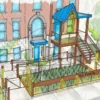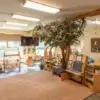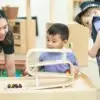Have you ever considered why we need to consciously select the texture, shape, color, and size of materials used by children in the classroom? Or what difference furniture selection makes to the learning environment?
A study by the University of Salford (2015) found that “the physical characteristics of a classroom can impact student learning by up to 25%.” Carefully selecting the components of the classroom reduces stress and improves focus and engagement.
Children can spend up to 40 hours or more each week in an early childhood center. This may be due to family circumstances such as:
- Working parents
- Illness in the family
- Travel requirements
- Parent commitments
- Respite needs
- Parent preference
If children were at home for those 40+ hours a week, they would have free use of various rooms in a home, depending on the size and spatial configuration of the home they live in. Generally, each room is purpose-built—for example, the bedroom for sleeping, the bathroom for washing, the kitchen for preparing food, and the living room for relaxing. Each room features different textures, colors, shapes, and furniture, all with specific uses.
If such features and dedicated spaces exist at home, doesn’t it make sense that the one big room in an early childhood center should be divided into smaller, defined areas? Adding variety and interest keeps children’s (and adults’) brains engaged, supports creativity, solution finding, and calm thinking.


Brain Rules
In his book Brain Rules (2014), John Medina outlines 12 rules that support the needs of the brain. Here are three that highlight the importance of carefully curating learning spaces for children:
- We learn best through sensory experiences.
- We don’t learn if we are bored.
- We are born natural explorers.
If we keep these rules in mind, then providing a range of textures, colors, sizes, and shapes when offering loose parts, materials, and furniture addresses these “Brain Rules.” This supports all children, including those who may be hyper-sensitive (sensory avoiders) and hypo-sensitive (sensory seekers), to fully access playful learning in the environment.
As educators, this knowledge should influence our planning of materials, furniture, and resources to be included in the classroom design. Mindful planning supports brain development, addresses developmental and cultural needs, and incorporates the interests of children.


Classroom Inclusions for Calm Environments
Textures
The sense of touch is a powerful way of learning. Have you noticed in each of the rooms in your house that there are different textures for different purposes and effects? Having a range of sensory inputs that includes touch is important for children. Some children crave additional sensory experiences—they are the sensory seekers. Other children prefer minimal sensory exposure—they are sensory avoiders. In a classroom, we need to have multiple textures in small, defined spaces that appeal to both seekers and avoiders, and all children in between.
Putting textured tablecloths or placemats on tables, providing textured cushions to sit on, including a basket of different textured fabrics, and offering a range of natural elements like pinecones, rocks, and leaves gives children opportunities to explore and create in their own time and at their unique developmental level. As John Medina (2014) says, we learn best through sensory experiences.
Shapes
The shape of the furniture and materials used in the learning environment influences the perception of safety in the brain. Including round items such as bowls, wall clocks, placemats, tables, floor rugs, furniture with rounded edges, curves, and see-through shelving softens the look of the environment.
The brain cannot relax and enjoy sensory opportunities and skill-based learning experiences if it feels threatened or on high alert. This can happen if there is a lack of rounded corners. Rounded edges and corners calm the brain and soothe the split-second reaction of feeling threatened by right-angled, “sharp” corners on furniture. For an instant, these corners are perceived as dangerous in a child’s brain before it rationalizes the “threat” and recognizes safety in the space.
This doesn’t mean that every edge in the room must be curved or round. What it does mean is that we need to have a variety of shaped materials in the classroom. We need to soften the look of the environment and add to the brain’s sense of safety and security, allowing thinking to occur easily.
Sizes
John Medina reminds us that the brain “doesn’t do boring.” This means we need a variety of items of different sizes, heights, and depths in our learning environment. Using different furniture shapes and materials helps capture children’s imagination, stimulate creativity, and encourage exploration.
Sizes can also be used as a teaching tool to reinforce children’s understanding of schema—the way they classify and organize information. For example, classifying items using different criteria such as size, shape, color, and texture allows children to be exposed to a range of materials and explore the relationships between them. Having items ranging from tiny to oversized and everywhere in between helps children experience perspective and “measure” themselves against materials that are smaller or larger. Children are able to recognize spatial awareness and form understandings related to their place in the world and the size of objects. As Medina (2014) notes, we are born natural explorers.
Colors
Wild, bright colors that dominate the classroom can be taxing for the brain and make it harder to support calm thinking processes. Add in some brightly colored furniture, and we have an environment that is completely overstimulating for most children and adults. It was once thought that bright colors inspired learning, focus, and improved mood. It is now known that bright colors add to sensory overload and visual stimulation, which many children and teachers find difficult to cope with. An overly colorful room adds to chaos in the brain.
Natural colors reflect nature and the outdoors, which has a calming effect on the brain. Using a neutral palette in the classroom allows teachers and children to add to the room design with their artwork or other eclectic and interesting artifacts. Our intention is to calm the brain so that thinking and learning occur easily and naturally. Color should not overshadow the carefully curated spaces that incorporate sensory experience and interesting open-ended learning opportunities.
Furniture
If we are to continue with the intention of bringing textures, shapes, size, and color into the learning space, then the selection of furniture must also be part of our design process. Using brightly colored, plastic, or metal tables and chairs provides an institutional look and feel and is often the first thing noticed when entering a classroom. This can create a sense of overwhelm and disconnect for children.
Furniture should not be the focal point of the room. It should almost fade into the background. The stars of the room should be the children engaging with the carefully planned and selected materials that invite them into learning spaces to practice and develop their skills. A calm, emotional response occurs when furniture is selected wisely.
If we choose neutral, durable wood furniture with softened edges and curves, we help calm the brain and support learning in the classroom. Imagine being able to choose wood tables that are practical and can be easily raised or lowered as needed for multiple purposes. Consider the softness added to the room when shelving units with curved edges and different heights are used. This allows children to see over them and reinforces a sense of safety. Wood grain tables that look textured but have a smooth surface are ready to accept placemats, tablecloths, cane baskets, and other textured materials to encourage investigation. This supports the idea that we are all “born natural explorers” (Medina, 2014) and enjoy the sensory experience of touching a range of different materials, while variety means that “we don’t do boring.”
Conclusion
In a calm classroom environment, learning occurs naturally and easily. When we consciously select elements that work together in a learning environment to calm the brain, we create optimum opportunities. Children and teachers are engaged in learning and teaching while taking care of their well-being by having a calm and less stressed brain. The Brain-SET Environments Formula® incorporates this practice when designing a classroom with the aim of achieving the mantra: “a calm brain is a thinking brain.”
To get your copy of the Calm Classroom Cheatsheet, click here.
About Contributing Author Dr. Kathryn Murray

Dr. Kathryn Murray is the founder of Future Strong Education Consultancy. She is a globally renowned, award-winning early childhood specialist, sought-after public speaker, workshop facilitator and coach. A pedagogical expert who continues to evolve her original Brain-SET Environments Formula® research, she feels strongly that all children should be given the best possible start in life. Dr. Murray lives on the Sunshine Coast in Australia.
Read all of Dr. Kathryn Murray's contributed stories on naturalpod.com












